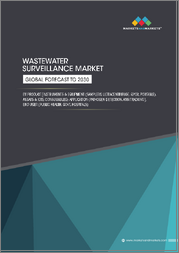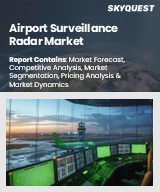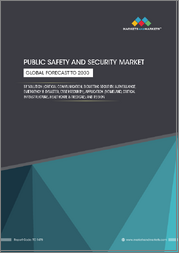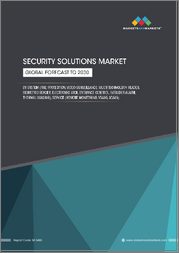
|
시장보고서
상품코드
1797677
세계의 서멀 시스템 레벨 감시 시장 : 유형, 카테고리, 기술, 용도, 플랫폼, 최종사용자, 지역별(-2032년)Global Thermal System-level Surveillance Market by Type, by Category, by Technology, by Application, by Platform, by End User, and by Region Forecast till 2032 |
||||||
세계 열 시스템 레벨 모니터링 시장 규모는 2023년 12억 9,083만 달러에서 예측 기간 동안 연평균 6.6%의 꾸준한 성장세를 보이며 2032년에는 27억 1,640만 달러에 달할 것으로 예측됩니다.
열화상 시스템 수준의 모니터링은 국방, 국경 보안, 전략적 인프라 보호를 위해 설계된 차세대 열화상 플랫폼에 특화된 세계 시장입니다. AI 기반 분석과 고성능 열 센서를 결합한 이 솔루션은 모든 날씨와 조명 조건에서 신뢰할 수 있는 감지 기능을 제공함으로써 실시간 인텔리전스 및 예방적 위협 관리에 필수적인 역할을 하고 있습니다.
각국의 관할 구역에서 열화상 감시 시스템 도입은 큰 시장 성장을 창출하고 있으며, 그 주요 원동력은 국방 예산의 급격한 증가에 기인하고 있습니다. 군사 기관은 국경의 안전을 보장하고 잠재적 분쟁 지역을 감시하고 정보 활동에 필요한 지원을 제공하기 위해 군에 최첨단 열화상 기술을 도입하고 있습니다. UAV 탑재 열화상 카메라부터 장거리 감시 시스템까지, 정부는 전천후, 주야간 감시를 목적으로 기술 도입에 집중하고 있습니다. NATO의 첨단 정찰 솔루션 분야에 대한 투자와 같은 전략적 현대화 프로그램은 지상군, 장갑차, 주변 경비에서 통합 열화상 감시 전술로의 전환을 보여주는 좋은 예 중 하나입니다.
지역별 분석
북미는 고부가가치 시장으로 UAV 탑재형 및 AI 기반 열화상 카메라에 대한 국방 주도 투자가 시장을 주도하고 있습니다. 국토 안보의 우선순위와 더불어 빈번하게 발생하는 산불에 대한 대응도 국방 및 재난 관리 분야에서 광범위한 도입을 촉진하고 있습니다. 미국은 3억 8,040만 달러, 캐나다는 1억 4,300만 달러로 북미가 열 시스템 레벨 모니터링 시장에 가장 큰 기여를 하는 지역으로 자리매김했습니다.
유럽에서는 지정학적 불안정성에 따라 실시간 국경 감시 및 주변 보안에 대한 수요가 증가하면서 도입이 확대되고 있습니다. 독일, 프랑스, 영국의 멀티센서형 열화상 시스템에 대한 막대한 투자가 수요를 형성하고 있으며, 대 UAS 프로그램이 지역 안보를 강화하고 있습니다. 독일(8,300만 달러), 영국(6,930만 달러), 프랑스(6,130만 달러)가 유럽 내 첨단 열화상 기술에 대한 투자 확대를 보여주는 대표적인 사례입니다.
아시아태평양은 가장 강력한 성장 잠재력을 가지고 있으며, 중국, 인도, 한국의 국방 예산 증가와 군사 현대화가 그 배경입니다. 각국 정부는 열화상 카메라를 국방 분야뿐만 아니라 스마트 시티 네트워크, 교통 관리 시스템, 해안 감시 등에 활용하고 있습니다. 중국이 9,890만 달러 규모로 지역을 선도하고 있으며, 인도(6,520만 달러), 일본(4,690만 달러)이 방산과 상업 분야 모두에서 도입이 확대되고 있는 것을 반영하고 있습니다.
세계의 서멀 시스템 레벨 모니터링(Thermal System Level Monitoring) 시장을 조사했으며, 시장 정의와 개요, 시장 성장에 영향을 미치는 각종 영향요인 분석, 시장 규모 추이와 예측, 각종 부문별/지역별/주요 국가별 분석, 경쟁 환경, 주요 기업 개요 등의 정보를 정리하여 전해드립니다.
목차
제1장 주요 요약
제2장 시장 서론
제3장 조사 방법
제4장 시장 역학
- 성장 촉진요인
- 성장 억제요인
- 기회
- 동향
- COVID-19의 영향 분석
제5장 시장 요인 분석
- 공급망 분석
- Porter's Five Forces 모델
- SWOT 분석
- PESTEL 분석
제6장 세계의 서멀 시스템 레벨 감시 카메라 시장 : 유형별
- 고정 카메라
- 휴대용 카메라 및 핸드헬드 카메라
제7장 세계의 서멀 시스템 레벨 감시 카메라 시장 : 카테고리별
- 장파 적외선(LWIR)
- 중파 적외선(MWIR)
- 단파 적외선(SWIR)
제8장 세계의 서멀 시스템 레벨 감시 카메라 시장 : 기술별
- 냉각 서멀 이미징
- 비냉각 서멀 이미징
제9장 세계의 서멀 시스템 레벨 감시 카메라 시장 : 용도별
- 감시 및 표적 설정
- COUNTER-UAS
제10장 세계의 서멀 시스템 레벨 감시 카메라 시장 : 플랫폼별
- 육상 서멀 시스템
- 공중 서멀 시스템
- 해상 서멀 시스템
제11장 세계의 서멀 시스템 레벨 감시 카메라 시장 : 최종사용자별
- 군/방위용 서멀 시스템
- 국토안보 서멀 시스템
제12장 세계의 서멀 시스템 레벨 감시 카메라 시장 : 지역별
- 개요
- 북미
- 미국
- 캐나다
- 유럽
- 독일
- 영국
- 프랑스
- 러시아
- 이탈리아
- 스페인
- 기타
- 아시아태평양
- 중국
- 인도
- 일본
- 호주
- 말레이시아
- 태국
- 인도네시아
- 기타
- 남미
- 브라질
- 멕시코
- 아르헨티나
- 기타
- 중동 및 아프리카
- GCC 국가
- 남아프리카공화국
- 기타
제13장 경쟁 구도
- 시장 점유율 분석
- 경쟁 대시보드
- 주요 전개 및 성장 전략
제14장 기업 개요
- ASELSAN
- LYNRED USA
- HENSOLDT
- ELBIT SYSTEMS
- FLIR
- XENICS
- THALES
- LEONARDO
- SIERRA-OLYMPIA TECH
- EXCELITAS
- INFINITI ELECTRO-OPTICS
Global Thermal System-level Surveillance Market by Type (Fixed Cameras, Portable and Handheld Cameras), by Category (Long-Wave Infrared, Mid-Wave Infrared, Short-Wave Infrared), by Technology (Cooled Thermal Imaging, Uncooled Thermal Imaging), by Application (Surveillance and Targeting, Counter-UAS), by Platform (Land, Airborne, Naval), by End User (Military/Defense, Homeland Security), and by Region (North America, Europe, APAC, South America, MEA) Forecast till 2032
Industry Overview
The global thermal system-level surveillance market is set to expand from USD 1,290.83 million in 2023 to USD 2,716.4 million by 2032, reflecting a healthy CAGR of 6.6% over the forecast period. Thermal system-level surveillance represents a global market dedicated to next-generation thermal imaging platforms designed for defense, border security, and strategic infrastructure protection. These solutions, combining AI-driven analytics with high-performance thermal sensors, ensure reliable detection in all weather and lighting conditions, making them indispensable for real-time intelligence and proactive threat management.
The implementation of thermal surveillance systems in various jurisdictional domains has garnered significant market growth, which was mostly propelled by the sharp increase in defense budgets. Military agencies are installing cutting-edge thermal imaging in their armed forces to reassure the security of borders, as well as to keep a close eye on areas of potential hostilities and offer spies their required support for their operations. The range of technology from UAV-mounted thermal cameras to long-range surveillance systems is what governments are concentrating on when talking about all-weather, day-and-night monitoring. The strategic modernization programs, such as NATO's investments in the field of high-tech reconnaissance solutions, are one of the several examples of the ongoing transition to the use of integration-based thermal surveillance tactics for ground forces, armored vehicles, as well as perimeter security.
Major Company Development
Leonardo has advanced its position in the global thermal system-level surveillance market through a series of high-impact developments. The company has heavily invested in R&D, embedding AI and machine learning into its Osprey and Mirage platforms to deliver autonomous tracking and real-time analysis. Product innovation remains central, with the Mirage 400 enhancing range and resolution, and the Osprey 1000 targeting the fast-growing UAV surveillance segment. Geographic expansion in Asia-Pacific and the Middle East, combined with the launch of a global 24/7 service platform, strengthens market penetration.
Key Players
Major players in the global thermal system-level surveillance market are Teledyne FLIR LLC, Hikvision, Dahua Technology, Axis Communications, Bosch Security Systems, Honeywell Security, Panasonic, Sony, Samsung, and Aselsan.
Report Attribute Details
Market Size 2023 USD 1290.83 Million
Market Size 2032 USD 2,716.4 Million
CAGR (2024-2032) 6.6%
Base Year 2023
Market Forecast Period 2024-2032
Historical Data 2019-2024
Industry Segmentations
By Type: Fixed Cameras - 8.3%, Portable and Handheld Cameras - 10.2%.
By Category: Long-Wave Infrared - 8.3%, Mid-Wave Infrared - 9.2%.
By Technology: Cooled Thermal Imaging - 8.4%, Uncooled Thermal Imaging - 10.7%.
By Application: Surveillance and targeting - 8.0%, Counter-UAS - 10.9%.
By Platform: Land - 5.4%, Airborne - 7.9%.
by End User: Military/Defense - 5.7%, Homeland Security - 9.2%.
Regional Analysis
North America represents a high-value market where defense-led investments in UAV-mounted and AI-driven thermal cameras dominate. Homeland security priorities, coupled with frequent wildfire incidents, are spurring widespread deployment in both defense and disaster management. With the U.S. generating USD 380.4 million and Canada adding USD 104.3 million, North America remains the largest contributor to the thermal system-level surveillance market.
Europe is scaling up adoption as geopolitical instability heightens the need for real-time border and perimeter surveillance. Heavy investments from Germany, France, and the UK in multi-sensor thermal systems are shaping demand, while counter-UAS programs reinforce regional security initiatives. Germany (USD 83.0 million), the UK (USD 69.3 million), and France (USD 61.3 million) highlight Europe's growing investment in advanced thermal imaging technologies for security and defense.
The Asia-Pacific region offers the strongest growth prospects, underpinned by rising defense budgets and military modernization in China, India, and South Korea. Beyond defense, governments are embedding thermal cameras into smart city networks, traffic management systems, and coastal surveillance. China's USD 98.9 million market leads the region, while India and Japan, at USD 65.2 million and USD 46.9 million respectively, reflect expanding adoption in both defense and commercial sectors.
South America is steadily investing in advanced surveillance systems to address border security, terrorism, and critical infrastructure challenges. Industrial integration in oil & gas, mining, and transportation is adding new layers of demand.
The MEA market reflects a balance of defense modernization and civilian adoption. GCC nations are leading investments in border and maritime surveillance, while African countries integrate thermal technologies into anti-poaching, urban monitoring, and disaster relief.
TABLE OF CONTENTS
1 EXECUTIVE SUMMARY
2 MARKET INTRODUCTION
- 2.1 DEFINITION
- 2.2 SCOPE OF THE STUDY
- 2.3 RESEARCH OBJECTIVE
- 2.4 MARKET STRUCTURE
3 RESEARCH METHODOLOGY
- 3.1 OVERVIEW
- 3.2 DATA FLOW
- 3.2.1 DATA MINING PROCESS
- 3.3 PURCHASED DATABASE:
- 3.4 SECONDARY SOURCES:
- 3.4.1 SECONDARY RESEARCH DATA FLOW:
- 3.5 PRIMARY RESEARCH:
- 3.5.1 PRIMARY RESEARCH DATA FLOW:
- 3.5.2 PRIMARY RESEARCH: NUMBER OF INTERVIEWS CONDUCTED
- 3.5.3 PRIMARY RESEARCH: REGIONAL COVERAGE
- 3.6 APPROACHES FOR MARKET SIZE ESTIMATION:
- 3.6.1 REVENUE ANALYSIS APPROACH
- 3.7 DATA FORECASTING
- 3.7.1 DATA FORECASTING TECHNIQUE
- 3.8 DATA MODELING
- 3.8.1 MICROECONOMIC FACTOR ANALYSIS:
- 3.8.2 DATA MODELING:
4 MARKET DYNAMICS
- 4.1 INTRODUCTION
- 4.2 DRIVERS
- 4.2.1 INCREASING MILITARY EXPENDITURE
- 4.2.2 TECHNOLOGICAL ADVANCEMENTS IN THERMAL IMAGING
- 4.2.3 GROWING DEMAND FOR SURVEILLANCE AND SECURITY SYSTEMS
- 4.2.4 RISING GLOBAL GEOPOLITICAL TENSIONS
- 4.2.5 GOVERNMENT REGULATIONS AND STANDARDS FOR DEFENSE EQUIPMENT
- 4.3 RESTRAINTS
- 4.3.1 HIGH POWER CONSUMPTION
- 4.3.2 BULKIER SIZE AND WEIGHT
- 4.3.3 LIMITED IMAGE RESOLUTION
- 4.3.4 HIGH MAINTENANCE COSTS
- 4.3.5 ENVIRONMENTAL LIMITATIONS
- 4.4 OPPORTUNITY
- 4.4.1 INTEGRATION OF ARTIFICIAL INTELLIGENCE FOR ENHANCED ANALYTICS
- 4.4.2 EXPANSION OF COMMERCIAL APPLICATIONS IN ENERGY AND ENVIRONMENTAL MONITORING
- 4.4.3 EMERGING MARKETS INVESTMENTS IN INFRASTRUCTURE DEVELOPMENT
- 4.4.4 PARTNERSHIPS WITH TECHNOLOGY STARTUPS FOR INNOVATIVE SOLUTIONS
- 4.4.5 GROWING FOCUS ON BORDER SECURITY AND ANTI-TERRORISM MEASURES
- 4.5 TRENDS
- 4.5.1 ADVANCEMENTS IN WEARABLE THERMAL IMAGING DEVICES
- 4.5.2 INTEGRATION OF AI-POWERED THERMAL IMAGING
- 4.5.3 LAUNCH OF HIGH-SENSITIVITY THERMAL CAMERAS FOR ALL-WEATHER DETECTION
- 4.5.4 INTEGRATION OF THERMAL IMAGING IN BORDER AND MARITIME SECURITY
- 4.6 IMPACT ANALYSIS OF COVID - 19
- 4.6.1 INCREASED DEMAND FOR TEMPERATURE SCREENING SOLUTIONS IN PUBLIC SPACES, WORKPLACES, AND HEALTHCARE FACILITIES.
- 4.6.2 ACCELERATED DEVELOPMENT OF AI-POWERED THERMAL SCREENING SYSTEMS FOR AUTOMATED AND CONTACTLESS DETECTION.
- 4.6.3 EXPANSION INTO WORKPLACES & COMMERCIAL BUILDINGS.
- 4.6.4 INCREASED ADOPTION IN AIRPORTS & TRANSPORTATION HUBS.
- 4.6.5 INTEGRATION WITH AI FOR AUTOMATED DETECTION.
- 4.6.6 EXPANSION INTO EDUCATIONAL INSTITUTION.
- 4.6.7 EXPANSION INTO WORKPLACES & COMMERCIAL BUILDINGS.
5 MARKET FACTOR ANALYSIS
- 5.1 SUPPLY CHAIN ANALYSIS
- 5.1.1 RAW MATERIAL SUPPLIERS
- 5.1.2 INFRARED SENSOR & MICROBOLOMETER PRODUCTION
- 5.1.3 MANUFACTURING
- 5.1.4 ASSEMBLY & INTEGRATION
- 5.1.5 DISTRIBUTION AND LOGISTICS
- 5.1.6 END-USER APPLICATIONS
- 5.2 PORTER'S FIVE FORCES MODEL
- 5.2.1 BARGAINING POWER OF SUPPLIERS
- 5.2.2 BARGAINING POWER OF BUYERS
- 5.2.3 THREAT OF NEW ENTRANTS
- 5.2.4 THREAT OF SUBSTITUTES
- 5.2.5 INTENSITY OF RIVALRY
- 5.3 SWOT ANALYSIS
- 5.3.1 STRENGTHS
- 5.3.2 WEAKNESSES
- 5.3.3 OPPORTUNITIES
- 5.3.4 THREATS
- 5.4 PESTEL ANALYSIS
- 5.4.1 POLITICAL FACTORS
- 5.4.2 ECONOMIC FACTORS
- 5.4.3 SOCIAL FACTORS
- 5.4.4 TECHNOLOGICAL FACTORS
- 5.4.5 ENVIRONMENTAL FACTORS
- 5.4.6 LEGAL FACTORS
6 GLOBAL THERMAL SYSTEM-LEVEL SURVEILLANCE CAMERA MARKET, BY TYPE
- 6.1 INTRODUCTION
- 6.2 FIXED CAMERAS
- 6.3 PORTABLE AND HANDHELD CAMERAS
7 GLOBAL THERMAL SYSTEM-LEVEL SURVEILLANCE CAMERA MARKET, BY CATEGORY
- 7.1 INTRODUCTION
- 7.2 LONG-WAVE INFRARED (LWIR)
- 7.3 MID-WAVE INFRARED (MWIR)
- 7.4 SHORT-WAVE INFRARED (SWIR)
8 GLOBAL THERMAL SYSTEM-LEVEL SURVEILLANCE CAMERA MARKET, BY TECHNOLOGY
- 8.1 INTRODUCTION
- 8.1.1 COOLED THERMAL IMAGING
- 8.1.2 UNCOOLED THERMAL IMAGING
9 GLOBAL THERMAL SYSTEM-LEVEL SURVEILLANCE CAMERA MARKET, BY APPLICATION
- 9.1 INTRODUCTION
- 9.1.1 SURVEILLANCE AND TARGETING
- 9.1.2 COUNTER-UAS
10 GLOBAL THERMAL SYSTEM-LEVEL SURVEILLANCE CAMERA MARKET, BY PLATFORM
- 10.1 INTRODUCTION
- 10.1.1 LAND-BASED THERMAL SYSTEMS
- 10.1.2 AIRBORNE THERMAL SYSTEMS
- 10.1.3 NAVAL THERMAL SYSTEMS
11 GLOBAL THERMAL SYSTEM-LEVEL SURVEILLANCE CAMERA MARKET, BY END USER
- 11.1 INTRODUCTION
- 11.1.1 MILITARY/DEFENSE THERMAL SYSTEMS
- 11.1.2 HOMELAND SECURITY THERMAL SYSTEMS
12 GLOBAL THERMAL SYSTEM-LEVEL SURVEILLANCE CAMERA MARKET, BY REGION
- 12.1 OVERVIEW
- 12.2 NORTH AMERICA
- 12.2.1 US
- 12.2.2 CANADA
- 12.3 EUROPE
- 12.3.1 GERMANY
- 12.3.2 UK
- 12.3.3 FRANCE
- 12.3.4 RUSSIA
- 12.3.5 ITALY
- 12.3.6 SPAIN
- 12.3.7 REST OF EUROPE
- 12.4 ASIA PACIFIC
- 12.4.1 CHINA
- 12.4.2 INDIA
- 12.4.3 JAPAN
- 12.4.4 AUSTRALIA
- 12.4.5 MALAYSIA
- 12.4.6 THAILAND
- 12.4.7 INDONESIA
- 12.4.8 REST OF APAC
- 12.5 SOUTH AMERICA
- 12.5.1 BRAZIL
- 12.5.2 MEXICO
- 12.5.3 ARGENTINA
- 12.5.4 REST OF SOUTH AMERICA
- 12.6 MEA
- 12.6.1 GCC COUNTRIES
- 12.6.2 SOUTH AFRICA
- 12.6.3 REST OF MEA
13 COMPETITIVE LANDSCAPE
- 13.1 INTRODUCTION
- 13.2 MARKET SHARE ANALYSIS, 2023
- 13.3 COMPETITOR DASHBOARD
- 13.4 KEY DEVELOPMENTS & GROWTH STRATEGIES
- 13.4.1 LAUNCH DEVELOPMENTS
14 COMPANY PROFILES
- 14.1 ASELSAN
- 14.1.1 COMPANY OVERVIEW
- 14.1.2 TYPES OFFERED
- 14.1.3 SWOT ANALYSIS
- 14.1.4 KEY STRATEGY
- 14.2 LYNRED USA
- 14.2.1 COMPANY OVERVIEW
- 14.2.2 TYPES OFFERED
- 14.2.3 SWOT ANALYSIS
- 14.2.4 KEY STRATEGY
- 14.3 HENSOLDT
- 14.3.1 COMPANY OVERVIEW
- 14.3.2 TYPES OFFERED
- 14.3.3 SWOT ANALYSIS
- 14.3.4 KEY STRATEGY
- 14.4 ELBIT SYSTEMS
- 14.4.1 COMPANY OVERVIEW
- 14.4.2 TYPES OFFERED
- 14.4.3 SWOT ANALYSIS
- 14.4.4 KEY STRATEGY
- 14.5 FLIR
- 14.5.1 COMPANY OVERVIEW
- 14.5.2 TYPES OFFERED
- 14.5.3 SWOT ANALYSIS
- 14.5.4 KEY STRATEGY
- 14.6 XENICS
- 14.6.1 COMPANY OVERVIEW
- 14.6.2 TYPES OFFERED
- 14.6.3 SWOT ANALYSIS
- 14.6.4 KEY STRATEGY
- 14.7 THALES
- 14.7.1 COMPANY OVERVIEW
- 14.7.2 TYPES OFFERED
- 14.7.3 SWOT ANALYSIS
- 14.7.4 KEY STRATEGY
- 14.8 LEONARDO
- 14.8.1 COMPANY OVERVIEW
- 14.8.2 TYPES OFFERED
- 14.8.3 SWOT ANALYSIS
- 14.8.4 KEY STRATEGY
- 14.9 SIERRA-OLYMPIA TECH
- 14.9.1 COMPANY OVERVIEW
- 14.9.2 TYPES OFFERED
- 14.9.3 SWOT ANALYSIS
- 14.9.4 KEY STRATEGY
- 14.10 EXCELITAS
- 14.10.1 COMPANY OVERVIEW
- 14.10.2 TYPES OFFERED
- 14.10.3 SWOT ANALYSIS
- 14.10.4 KEY STRATEGY
- 14.11 INFINITI ELECTRO-OPTICS
- 14.11.1 COMPANY OVERVIEW
- 14.11.2 TYPES OFFERED
- 14.11.3 SWOT ANALYSIS
- 14.11.4 KEY STRATEGY



















